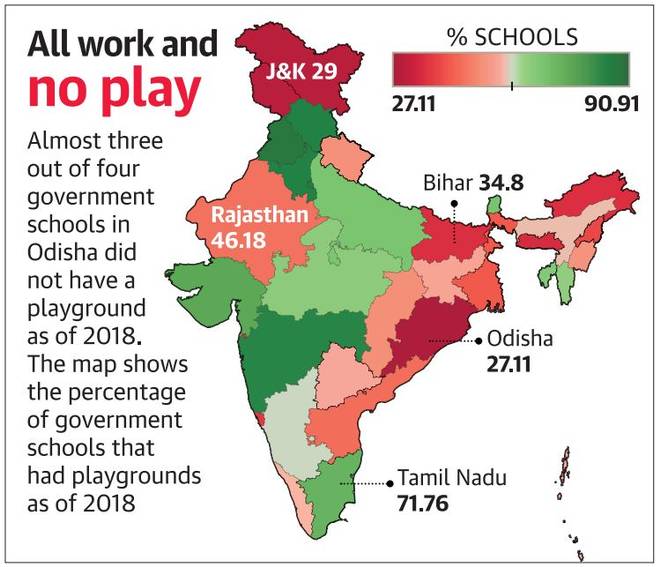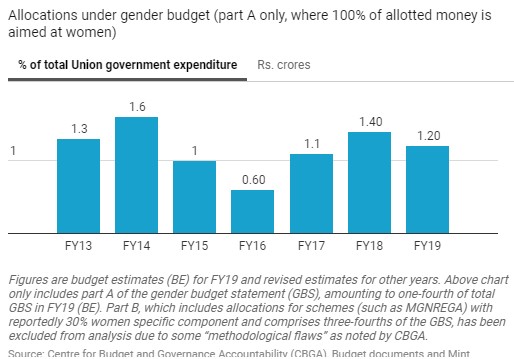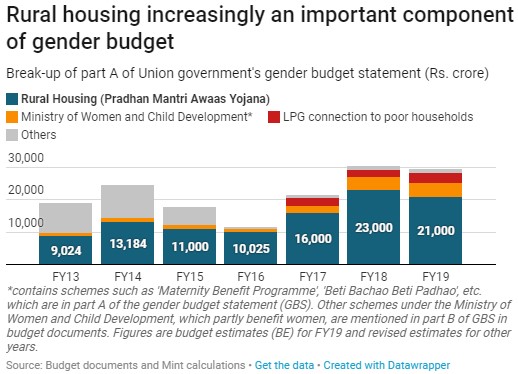Contents:
- Over 40% govt. schools don’t have power, playgrounds
- Mason, centenarians, artists among Nari Shakti winners
- Gender Budget: Rhetoric, Reality
- Global Crude Oil War brings good tidings for India
- How demand for Organic Food is Driving Biotech Innovation
OVER 40% GOVT. SCHOOLS DON’T HAVE POWER, PLAYGROUNDS
Focus: GS-II Social Justice
Why in news?
- Almost half of government schools in the country don’t have any electricity or playgrounds, according to a parliamentary panel on education.
- It identified shortfalls in both budgetary funding and utilisation, resulting in critical infrastructure gaps.
Concerns of the Parliamentary Standing Committee
- The Parliamentary Standing Committee on Human Resource Development (HRD), in its report on the 2020-2021 demand for grants for school education, expressed concern that the budgetary allocations saw a 27% cut from proposals made by the School Education department.
- The panel “expressed dismay” at the stark deficits in government school infrastructure, citing the latest survey data.
- The parliamentary panel also expressed concern about the rate of progress in building classrooms, labs and libraries to strengthen government higher secondary schools. Out of 2,613 sanctioned projects for 2019-20, only three had been completed in the first nine months of the financial year, said the panel, warning that such delays would alienate students from government schools.
Details of the Shortcomings

- Only 56% of schools have electricity, with the lowest rates in Manipur and Madhya Pradesh, where less than 20% have access to power.
- Less than 57% of schools have playgrounds, including less than 30% of schools in Odisha and Jammu and Kashmir, according to the Unified District Information System for Education (UDISE) 2017-18 survey.
- Almost 40% of schools did not have a boundary wall, endangering the safety of students and school property.
Recommendations of the Committee
The panel recommended that:
- The HRD Ministry collaborate with the Mahatma Gandhi National Rural Employment Guarantee Scheme (MGNREGS) to construct boundary walls
- The HRD Ministry can also work with the Ministry of New and Renewable Energy to provide solar energy and other renewable energy sources so that schools have access to power.
- The department should look into the factors impeding the infrastructure development and resolve them at the earliest so as to ensure that the students get the best possible facilities.
Main Objectives of HRD (Human Resource Development) Ministry
- Formulating the National Policy on Education and to ensure that it is implemented in letter and spirit
- Planned development, including expanding access and improving quality of the educational institutions throughout the country, including in regions where people do not have easy access to education.
- Paying special attention to disadvantaged groups like the poor, females and the minorities
- Provide financial help in the form of scholarships, loan subsidy, etc. to deserving students from deprived sections of the society.
- Encouraging international cooperation in the field of education, including working closely with the UNESCO and foreign governments as well as Universities, to enhance the educational opportunities in the country.
Samagra Shiksha Scheme
- Samagra Shiksha is an overarching programme for the school education sector extending from pre-school to class 12.
- The scheme has been prepared with the broader goal of improving school effectiveness measured in terms of equal opportunities for schooling and equitable learning outcomes.
- It subsumes the three Schemes of Sarva Shiksha Abhiyan (SSA), Rashtriya Madhyamik Shiksha Abhiyan (RMSA) and Teacher Education (TE).
The major objectives of the Samagra Shiksha Scheme are
- Provision of quality education and enhancing learning outcomes of students;
- Bridging Social and Gender Gaps in School Education;
- Ensuring equity and inclusion at all levels of school education;
- Ensuring minimum standards in schooling provisions;
- Promoting Vocationalisation of education;
- Support States in implementation of Right of Children to Free and Compulsory Education (RTE) Act, 2009; and
- Strengthening and up-gradation of SCERTs/State Institutes of Education and DIET as a nodal agencies for teacher training.
Major Features of the Samagra Shiksha Scheme
- Holistic Approach to Education
- Administrative Reforms
- Enhanced Funding for Education
- Focus on Quality of Education
- Focus on Digital Education
- Strengthening of Schools
- Focus on Girl Education
- Focus on Inclusion
- Focus on Skill Development
- Focus on Sports and Physical Education
- Focus on regional Balance
MASON, CENTENARIANS, ARTISTS AMONG NARI SHAKTI WINNERS
Focus: GS-II Social Justice, Women Empowerment, Prelims
Why in news?
A mason, a centenarian athlete, Jharkhand’s “Lady Tarzan” and a “mushroom mahila” were among the 15 women awarded the Nari Shakti Puraskar by President Ram Nath Kovind, on 8th March 2020, on account of International Women’s Day.
The government gives away the awards every year to recognise the service of women towards the cause of women’s empowerment and social welfare.
Nari Shakti Puraskar
- Nari Shakti Puraskar (formerly Stree Shakti Puraskar), literally meaning “Woman Power Award”, is India’s highest civilian award for recognising the achievements and contributions of women.
- The awards are given away by the President of India every year on 8 March, International Women’s Day at Rashtrapati Bhavan in New Delhi.
- The Nari Shakti Puraskar is conferred on individual women, public and private institutions and public departments for their activism and/ or their contributions to the cause of women’s empowerment.
- The award, instituted in the year 1999 by the Ministry of Women and Child Development, Government of India, is given in six institutional categories and two individual categories.
GENDER BUDGET: RHETORIC, REALITY
Focus: GS-II Social Justice, GS-III Indian Economy, Prelims
Why in news?
- Budgetary allocations for “100% women-specific programmes” in 2018-19, as listed in Part A of the Gender Budget Statement (GBS), declined.
- Despite some sops to women: a cut in provident fund contribution, and 80 million free gas connections for poor women, a closer examination of allocation of funds reveals that the budget had very little for women in it.
Pradhan Mantri Awaas Yojana -Gramin (PMAY-G)
- The gender budget is organized in two parts, A and B.
- The biggest component of GBS (Part A) in recent years has been the subsidized rural housing programme: the Pradhan Mantri Awaas Yojana -Gramin (PMAY-G), formerly called the Indira Awaas Yojana.

- However, the PMAY-G is not targeted specifically towards women.
- The scheme guidelines do not specify any fixed amount of money or share of houses to be granted to women, though female-headed households without a male member, or households having a single girl child, are given preference as beneficiaries.
- Though budgetary allotment for this scheme has shot up in recent years, houses built for women have fallen, both in absolute numbers and as a share of total houses built.

- Lack of demand is most probably not a reason for the fall in houses built for women. Census 2011 puts the total number of female-headed households in rural India at about 17.5 million.
- Out of them, 62%, or about 10 million households, live in kutcha (temporary) houses.
- Despite this apparent need for pucca houses, only about 5 million houses for women have been built under PMAY-G since 2010-11, according to data retrieved on 18 February.
- It’s thus misleading to include entire allocation for PMAY-G in gender budget especially when the number of houses built for women have been falling.
- Both centre and states need to take accountability for the slow completion rate of houses and disbursal of funds.
Other Schemes under MWCD
- The government has increased allocation for some schemes under the MWCD, such as the maternity benefit programme, Beti Bachao, Beti Padhao etc.
- The maternity benefit scheme provides a cash assistance to mothers for their first delivery to compensate wage loss.
- Spending on anganwadi services, or the “core Integrated Child Development Services”, has increased only marginally.
- Anganwadi services are the main mechanism by which the government administers programmes to improve the health and nutrition of pregnant women, nursing mothers and children up to six years of age.
- States have also neglected their duty in expanding this important programme. Some have a considerable deficit in the number of operational anganwadi centres as against the number sanctioned.
GLOBAL CRUDE OIL WAR BRINGS GOOD TIDINGS FOR INDIA
Focus: GS-III Indian Economy
Why in news?
Major oil buyers such as India are set to gain following Russia’s refusal to back broader cuts in crude oil production by the Organization of the Petroleum Exporting Countries (Opec).
Details
- Crude prices are on a tailspin after Russia did not agree to Opec’s proposal for an additional production cut of 1.5 million barrels per day (mbpd), amid a slump in demand following the Covid-19 outbreak.
- Prices are expected to witness more volatility, given Russia’s geo-strategic play in denying the production cut benefits to US shale oil producers and Saudi Arabia increasing production.
- The supply glut will have a wide-ranging impact on energy markets.
How does it impact India?
- With India spending $111.9 billion on oil imports in FY19, analysts are expecting a perfect storm in the energy markets that will help major consumers such as India manage inflationary and fiscal pressures.
- India is the world’s third-largest oil buyer, and the fourth-largest liquefied natural gas (LNG) importer.
- The Indian basket represents the average of Oman, Dubai and Brent crude.
- India has already begun to reap the gains with the three state-run oil marketing firms, Indian Oil Corp. Ltd, Bharat Petroleum Corp. Ltd and Hindustan Petroleum Corp. Ltd reducing the price of non-subsidized domestic cooking gas.
HOW DEMAND FOR ORGANIC FOOD IS DRIVING BIOTECH INNOVATION
Focus: GS-III Science and Technology
Why in news?
- The outbreak of novel coronavirus has refocused attention on animal farming practices and the additives that go into animal feed.
- Even otherwise, there’s been a growing consumer pushback against dairy, poultry and fish pumped up with antibiotics, hormones and chemicals.
- Demand for products from traceable, organic and naturally-bred animals is rising along with a shift to plant-based foods.
Start-ups are developing technologies to produce food in healthier and more sustainable ways. Some examples:
- Robots that improve performance and breeding conditions in poultry farms
- Digital tools to enhance the food value chain and respond to changing consumer expectations
- Hand-held device that can detect pesticide residue levels in food
- Fermenting methane into fish and poultry feed



